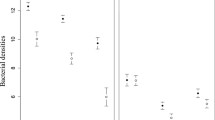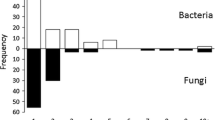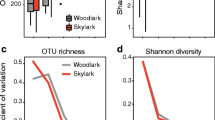Abstract
Parasites are known to exert selective pressures on host life history traits since the energy and nutrients needed to mount an immune response are no longer available to invest in other functions. Bird feathers harbour numerous microorganisms, some of which are able to degrade feather keratin (keratinolytic microorganisms) and affect feather integrity and colouration in vitro. Although named “feather-degrading” microorganisms, experimental evidence for their effects on feathers of free-living birds is still lacking. Here, we tested whether (i) keratinolytic microorganisms can degrade feathers in vivo and thus modify the colour of feathers during the nesting period and (ii) whether feather microorganisms have a long-term effect on the investment in colouration of newly moulted feathers. We designed treatments to either favour or inhibit bacterial growth, thus experimentally modifying plumage bacterial communities, in a wild breeding population of great tits (Parus major). Our analyses revealed no significant effects of the treatments on feather colours. Moreover, we found that differences in bacterial exposure during nesting did not significantly affect the colouration of newly moulted feathers. Our results suggest that significant feather degradation obtained during in vitro studies could have led to an overestimation of the potential of keratinolytic microorganisms to shape feather colouration in free-living birds.

Similar content being viewed by others
References
Aguilera E, Amat JA (2007) Carotenoids, immune response and the expression of sexual ornaments in male greenfinches (Carduelis chloris). Naturwissenschaften 94:895–902. doi:10.1007/s00114-007-0268-5
Burtt JE, Ichida J (1999) Occurrence of feather-degrading bacilli in the plumage of birds. Auk 116:364–372
Burtt EH, Schroeder MR, Smith LA et al (2011) Colourful parrot feathers resist bacterial degradation. Biol Lett 7:214–216. doi:10.1098/rsbl.2010.0716
Clayton D (1999) Feather-busting bacteria. Auk 116:302–304
Clayton DH, Moore J (1997) Host-parasite evolution: general principles and avian models. Press, Oxford University
Cook MI, Beissinger SR, Toranzos GA, Arendt WJ (2005) Incubation reduces microbial growth on eggshells and the opportunity for trans-shell infection. Ecol Lett 8:532–537
Cristol D, Armstrong J, Whitaker J (2005) Feather-degrading bacteria do not affect feathers on captive birds. Auk 122:222–230
Cuthill IC, Partridge JC, Bennett ATD et al (2000) Ultraviolet vision in birds. Adv Study Behav 29:159–215
Czirják GA, Møller AP, Mousseau TA, Heeb P (2010) Microorganisms associated with feathers of barn swallows in radioactively contaminated areas around chernobyl. Microb Ecol 60:373–380
Delhey K, Burger C, Fiedler W, Peters A (2010) Seasonal changes in colour: a comparison of structural, melanin- and carotenoid-based plumage colours. PLoS One 5:e11582. doi:10.1371/journal.pone.0011582
Economou T, Pournis N, Ntzimani A, Savvaidis IN (2009) Nisin–EDTA treatments and modified atmosphere packaging to increase fresh chicken meat shelf-life. Food Chem 114:1470–1476
Faust K, Sathirapongsasuti JF, Izard J et al (2012) Microbial co-occurrence relationships in the human microbiome. PLoS Comput Biol 8:e1002606
Galván I (2010) Plumage coloration can be perceived as a multiple condition-dependent signal by Great Tits Parus major. Ibis 152:359–367
Gilbert S, Sapp J, Tauber A (2012) A symbiotic view of life: we have never been individuals. Q Rev Biol 87:325–341
Giraudeau M, Czirják GÁ, Duval C et al (2010) No detected effect of moult on feather bacterial loads in mallards Anas platyrhynchos. J Avian Biol 41:678–680. doi:10.1111/j.1600-048X.2010.05144.x
Giraudeau M, Czirják GÁ, Duval C et al (2012) Effect of preen oil on plumage bacteria: an experimental test with the mallard. Behav Process 92:1–5
Gosler A (1993) The great tit. Hamlyn Species Guides, Paul Hamlyn, London
Gunderson AR (2008) Feather-degrading bacteria: a new frontier in avian and host-parasite research? Auk 125:972–979
Gunderson AR, Forsyth MH, Swaddle JP (2009) Evidence that plumage bacteria influence feather coloration and body condition of eastern bluebirds Sialia sialis. J Avian Biol 40:440–447. doi:10.1111/j.1600-048X.2008.04650.x
Harris L, Fleming H, Klaenhammer T (1992) Developments in nisin research. Food Res Int 25:57–66
Hill G, McGraw K (2006) Bird coloration, volume 2: function and evolution. Harvard University Press, Cambridge, MA
Hõrak P, Vellau H, Ots I, Møller AP (2000) Growth conditions affect carotenoid-based plumage coloration of great tit nestlings. Naturwissenschaften 87:460–464
Jacob S, Immer A, Leclaire S et al (2014) Uropygial gland size and composition varies according to experimentally modified microbiome in Great tits. BMC Evol Biol 14:134. doi:10.1186/1471-2148-14-134
Jacobs G (1981) Comparative color vision. Academic, New York
Kilgas P, Saag P, Mägi M et al (2012a) Variation in assemblages of feather bacteria in relation to plumage color in female great tits. Condor 114:606–611. doi:10.1525/cond.2012.110103
Kilgas P, Saag P, Mägi M et al (2012b) Plumage bacterial load increases during nest-building in a passerine bird. J Ornithol 153:833–838. doi:10.1007/s10336-011-0801-3
Lucas FS, Broennimann O, Febbraro I, Heeb P (2003) High diversity among feather-degrading bacteria from a dry meadow soil. Microb Ecol 45:282–290. doi:10.1007/s00248-002-2032-x
Lucas F, Moureau B, Jourdie V, Heeb P (2005) Brood size modifications affect plumage bacterial assemblages of European starlings. Mol Ecol 14:639–646. doi:10.1111/j.1365-294x.2005.02436.x
McFall-Ngai M, Hadfield MG, Bosch TCG et al (2013) Animals in a bacterial world, a new imperative for the life sciences. Proc Natl Acad Sci U S A 110:3229–3236
Metcalfe NB, Monaghan P (2013) Does reproduction cause oxidative stress? An open question. Trends Ecol Evol 28:347–350
Møller AP, Czirjak GÃ, Heeb P (2009) Feather micro-organisms and uropygial antimicrobial defences in a colonial passerine bird. Funct Ecol 23:1097–1102. doi:10.1111/j.1365-2435.2009.01594.x
Moreno-Rueda G (2010) Experimental test of a trade-off between moult and immune response in house sparrows Passer domesticus. J Evol Biol 23:2229–2237. doi:10.1111/j.1420-9101.2010.02090.x
Morgan XC, Segata N, Huttenhower C (2013) Biodiversity and functional genomics in the human microbiome. Trends Genet 29:51–58. doi:10.1016/j.tig.2012.09.005
Navara KJ, Hill GE (2003) Dietary carotenoid pigments and immune function in a songbird with extensive carotenoid-based plumage coloration. Behav Ecol 14:909–916. doi:10.1093/beheco/arg085
Olson VA, Owens IP (1998) Costly sexual signals: are carotenoids rare, risky or required? Trends Ecol Evol 13:510–514
Onifade AA, Al-Sane NA, Al-Musallam AA, Al-Zarban S (1998) A review: Potentials for biotechnological applications of keratin-degrading microorganisms and their enzymes for nutritional improvement of feathers and other keratins as livestock feed resources. Bioresour Technol 66:1–11. doi:10.1016/S0960-8524(98)00033-9
Ranjard L, Brothier E, Nazaret S (2000) Sequencing bands of ribosomal intergenic spacer analysis fingerprints for characterization and microscale distribution of soil bacterium populations responding to mercury spiking. Appl Environ Microbiol 66:5334–5339
Ruiz-De-Castañeda R, Gonzalez-Braojos S, Moreno J (2012) Bacterial degradability of an intrafeather unmelanized ornament: a role for feather-degrading bacteria in sexual selection? Biol J Linn Soc 105:409–419. doi:10.1111/j.1095-8312.2011.01806.x
Ruiz-Rodríguez M, Valdivia E, Soler JJ et al (2009) Symbiotic bacteria living in the hoopoe’s uropygial gland prevent feather degradation. J Exp Biol 212:3621–3626. doi:10.1242/jeb.031336
Saag P, Tilgar V, Mänd R et al (2011) Plumage bacterial assemblages in a breeding wild passerine: relationships with ecological factors and body condition. Microb Ecol 61:740–749. doi:10.1007/s00248-010-9789-0
Schmid-Hempel P (2011) Evolutionary parasitology: the integrated study of infections, immunology, ecology, and genetics. Press, Oxford University
Schulte-Hostedde A, Zinner B, Millar J, Hickling G (2005) Restitution of mass-size residuals: validating body condition indices. Ecology 84:155–163
Senar JC, Negro J, Quesada J et al (2008) Two pieces of information in a single trait? The yellow breast of the great tit (Parus major) reflects both and body condition pigment acquisition. Behaviour 145:1195–1210
Shawkey MD, Pillai SR, Hill GE (2003) Chemical warfare? Effects of uropygial oil on feather-degrading bacteria. J Avian Biol 34:345–349. doi:10.1111/j.0908-8857.2003.03193.x
Shawkey MD, Pillai SR, Hill GE et al (2007) Bacteria as an agent for change in structural plumage color: correlational and experimental evidence. Am Nat 169(Suppl):S112–S121. doi:10.1086/510100
Shawkey MD, Pillai SR, Hill GE (2009) Do feather-degrading bacteria affect sexually selected plumage color? Naturwissenschaften 96:123–128. doi:10.1007/s00114-008-0462-0
Slagsvold T, Lifjeld J (1985) Variation in plumage colour of the great tit Parus major in relation to habitat, season and food. J Zool 206:321–328
Vézina F, Gustowska A, Jalvingh K (2009) Hormonal correlates and thermoregulatory consequences of molting on metabolic rate in a northerly wintering shorebird. Physiol Biochem Zool 82:129–142
Wang JM, Firestone MK, Beissinger SR (2011) Microbial and environmental effects on avian egg viability: do tropical mechanisms act in a temperate environment? Ecology 92:1137–1145
Yamamura S, Morita Y, Hasan Q et al (2002) Keratin degradation: a cooperative action of two enzymes from Stenotrophomonas sp. Biochem Biophys Res Commun 294:1138–1143. doi:10.1016/S0006-291X(02)00580-6
Acknowledgements
We wish to dedicate this paper to our invaluable collaborator Léa Colmas who was recently sadly taken by an avalanche. Léa performed an excellent work during this study as part of her master’s. She was greatly appreciated and liked for her warmth, kindness and intellectual abilities and is profoundly missed. We thank the families Bordes, Gers and Labories who allowed us to install nest boxes on their site. Carole Sembeille, Marion Roullin, Marc Etchecopart Echechar and Charlotte Perrot helped during the fieldwork. We thank Mélanie Roy, Jean-Baptiste Ferdy and Pascal Le Bourgeois for discussions and Bob Montgomerie for useful comments on an earlier version of the manuscript. This work is part of the Laboratoires d’Excellence (LABEX) entitled TULIP (ANR-10-LABX-41).
Author information
Authors and Affiliations
Corresponding author
Additional information
Communicated by: Alexandre Roulin
Rights and permissions
About this article
Cite this article
Jacob, S., Colmas, L., Parthuisot, N. et al. Do feather-degrading bacteria actually degrade feather colour? No significant effects of plumage microbiome modifications on feather colouration in wild great tits. Naturwissenschaften 101, 929–938 (2014). https://doi.org/10.1007/s00114-014-1234-7
Received:
Revised:
Accepted:
Published:
Issue Date:
DOI: https://doi.org/10.1007/s00114-014-1234-7




